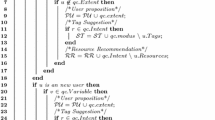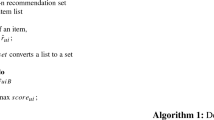Abstract
Benefit from technical advances in the Internet of Things, many social media applications relative to folksonomy have become ubiquitous. The size and complexity of folksonomy-based systems can unfortunately lead to information overload and reduced utility for users. Consequentially, the increasing need for recommender services from users has arisen. Many efforts have been made to address recommendation accuracy as well as other issues with respect to personalized recommendation in such systems. A key challenge facing these systems is that the most useful individual recommendations are to be found among diverse niche resources while increasing diversity most often compromises accuracy. In this paper, we introduce a simple yet elegant method—Diversity-aware Personalized PageRank (DaPPR)—to address this challenge from the aggregate perspective. DaPPR exploits a balance factor to adjust the influence of a personalized ranking vector and a unified non-personalized ranking vector based on PageRank. By this, it can reduce the impact of resource popularity on recommendations and then generate more diverse and novel recommendations to users. A hybrid DaPPR model that combines two ranking processes on the user–resource and the resource–tag bipartite graphs is specifically designed to meet the requirements in folksonomy-based systems. According to solid experiments, our proposed method yields better results balancing both aggregate accuracy and aggregate diversity (novelty). Improvements of all performance metrics are also obtained compared with the existing algorithms.












Similar content being viewed by others
References
Adomavicius G, Kwon Y (2012) Improving aggregate recommendation diversity using ranking-based techniques. IEEE Trans Knowl Data Eng 24(5):896–911
Bellogin A, Cantador I, Castells P (2013) A comparative study of heterogeneous item recommendations in social systems. Inf Sci 221:142–169
Boldi P, Santini M, Vigna S (2009) Pagerank: functional dependencies. ACM Trans Inf Syst 27:19
Bradley K, Smyth B (2001) Improving recommendation diversity. In: Proceedings of the twelfth national conference in artificial intelligence and cognitive science, 2001. Springer, pp 75–84
Brin S, Page L (1998) The anatomy of a large-scale hypertextual web search engine. Comput Netw 30:107–117
Cantador I, Brusilovsky I, Kuflik T (2011) 2nd workshop on information heterogeneity and fusion in recommender systems (hetrec 2011). In: Proceedings of the fifth ACM conference on recommender systems, ACM, pp 387–388
Fleder D, Hosanagar K (2009) Blockbuster cultures next rise or fall: the impact of recommender systems on sales diversity. Manag Sci 55:697–712
Fouss F, Pirotte A, Renders JM, Saerens M (2007) Random-walk computation of similarities between nodes of a graph with application to collaborative recommendation. IEEE Trans Knowl Data Eng 19:355–369
Gan M, Jiang R (2013) Improving accuracy and diversity of personalized recommendation through power law adjustments of user similarities. Decis Support Syst 55:811–821
Golder S, Huberman B (2006) Usage patterns of collaborative tagging systems. J Inf Sci 32:198–208
Gupta M, Li M, Yin Z, Han J (2010) Survey on social tagging techniques. ACM SIGKDD Explor 12:58–72
Haveliwala T (2003) Topic-sensitive pagerank: a context-sensitive ranking algorithm for web search. IEEE Trans Knowl Data Eng 15:784–796
Herlocker J, Konstan J, Terveen L, Riedl J (2004) Evaluating collaborative filtering recommender systems. ACM Trans Inf Syst 22:5–53
Huang Z, City J, Zeng D, Chen H (2007) A comparison of collaborative-filtering recommendation algorithms for e-commerce. IEEE Intell Syst 22:68–78
Hurley N, Zhang M (2011) Novelty and diversity in top-n recommendation analysis and evaluation. ACM Trans Int Technol 10:14
Jannach D, Lerche L, Gedikli F, et al (2013) What recommenders recommend-An analysis of accuracy, popularity, and sales diversity effects. In: Proceedings of the 21st conference on user modeling, adaptation and personalization, Springer, pp 25–37
Jaschke R, Marinho L, Hotho A, Schmidt-Thieme L, Stumme G (2008) Tag recommendations in social bookmarking systems. AI Commun 21:231–247
Konstas I, Stathopoulos I, Jose J (2009) On social networks and collaborative recommendation. In: Proceedings of the 32nd international ACM SIGIR conference on research and development in information retrieval, ACM, pp 195–202
Lathia N, Hailes S, Capra L, Amatriain X (2010) Temporal diversity in recommender systems. In: Proceedings of the 33rd international ACM SIGIR conference on research and development in information retrieval, ACM, pp 210–217
Liu J, Zhou J, Wang JF, Chen X, Zhou HN (2013) Cloud service: automatic construction and evolution of software process problem-solving resource space. J Supercomput 64(3):1108–1132
Luo XF, Xu Z, Yu J, Chen X (2011) Building association link network for semantic link on web resources. IEEE Trans Autom Sci Eng 8(3):482–494
McGinty L, Smyth B (2003) On the role of diversity in conversational recommender systems. In: Proceedings of the 5th international conference on case-based reasoning research and development, Springer, pp 276–290.
Niemann K, Wolpers M (2013) A new collaborative filtering approach for increasing the aggregate diversity of recommender systems. In: Proceedings of the 19th ACM SIGKDD international conference on knowledge discovery and data mining, ACM, pp 955–963
Patil CB, Wagh RB (2013) Recommendation diversity for web personalization: a survey. Int Mag Adv Comput Sci Telecommun 4:15–18
Servajean M, Pacitti E, Amer-Yahia S, et al (2013) Profile diversity in search and recommendation. In: Proceedings of the 22nd international conference on World Wide Web companion, ACM, pp 973–980
Smyth B, McClave P (2003) Similarity vs. diversity. In: Proceedings of the 3th International conference on case-based reasoning research and development, Springer, pp 347–361
Sun YC, Yan HL, Lu C, Bie RF, Zhou ZB (2013) Constructing the web of events from raw data in the web of things. J Mob Inf Syst. doi:10.3233/MIS-130173
Tong HH, He JR, Wen Z, Konuru R, Lin C (2011) Diversified ranking on large graphs: an optimization viewpoint. In: Proceedings of the 17th ACM SIGKDD international conference on knowledge discovery and data mining, ACM, pp 1028–1036
Vargas S, Castells P (2011) Rank and relevance in novelty and diversity metrics for recommender systems. In: Proceedings of the fifth ACM conference on recommender systems, 2011. ACM, pp 109–116
Wang J, Zhu J (2009) Portfolio theory of information retrieval. In: Proceedings of the 32nd international ACM SIGIR conference on research and development in information retrieval, ACM, pp 115–122
Wu H, Yu H, Li B, Pei YJ (2013) Personalized recommendation via rank aggregation in social tagging systems. In: Proceedings of the 10th international conference on fuzzy systems and knowledge discovery, IEEE, pp 912–916
Zhang ZK, Zhou T, Zhang YC (2011) Tag-aware recommender systems: a state-of-the-art survery. J Comput Sci Technol 26:767–777
Zhou T, Kuscsik Z, Liu JG, Medo M, Wakeling J, Zhang YC (2010) Solving the apparent diversity-accuracy dilemma of recommender systems. Proc Nat Acad Sci 107:4511–4515
Ziegler CN, McNee SM, Konstan JA, Lausen G (2005) Improving recommendation lists through topic diversification. In: Proceedings of the 14th international conference on World Wide Web, ACM, pp 22–32
Acknowledgments
This work was supported by the Applied Basic Research Project of Yunnan Province (No.2013FB009) and the Scientific Research Project of Yunnan University (No.2010YB024), Special Funds for “Middle-aged and Young Core Instructor Training Program” of Yunnan University, the National Natural Science Foundation of China (No.61070013, No.U1135005), and ”Hundred Talents Recruitment Program” of Global Experts of Hubei. This work of Jun He was supported by the National Natural Science Foundation of China (No.61203273). We are grateful to anonymous reviewers for their useful comments and suggestions which contribute to substantially improving this paper.
Author information
Authors and Affiliations
Corresponding authors
Rights and permissions
About this article
Cite this article
Wu, H., Cui, X., He, J. et al. On improving aggregate recommendation diversity and novelty in folksonomy-based social systems. Pers Ubiquit Comput 18, 1855–1869 (2014). https://doi.org/10.1007/s00779-014-0785-0
Received:
Accepted:
Published:
Issue Date:
DOI: https://doi.org/10.1007/s00779-014-0785-0




